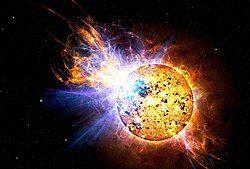EV Lacertae
| EV Lacertae | |
|---|---|
| Uma curva de luz ultravioleta para EV Lacertae, adaptada de Abdul-Aziz et al. (1995)[1] | |
| Dados observacionais (J2000) | |
| Constelação | Lacerta |
| Asc. reta | 22h 46m 49.7323s[2] |
| Declinação | 44° 20′ 02.368″[2] |
| Magnitude aparente | 10,09 |
| Características | |
| Tipo espectral | M3.5[3] |
| Cor (U-B) | +0,83[4] |
| Cor (B-V) | +1,36[4] |
| Variabilidade | Estrela eruptiva |
| Astrometria | |
| Velocidade radial | -1,5[2] km/s |
| Paralaxe | 197,9573[5] mas ± 0.0220 |
| Distância | 16.476 anos-luz 5.0516 pc |
| Detalhes | |
| Massa | 0,35[6] M☉ |
| Raio | 0,36[6] R☉ |
| Temperatura | 3 400[7] K |
| Metalicidade | -0,01[7] dex |
| Rotação | 4,3760[8] dias |
| Idade | 300 000 000 anos |
| Outras denominações | |
| GJ 873, BD+43 4305, LHS 3853, LTT 16695, HIP 112460, PLX 5520 | |
EV Lacertae (EV Lac, Gliese 873, HIP 112460) é uma estrela anã vermelha localizada à 16.5 anos-luz de distância na constelação de Lacerta, sendo a estrela mais próxima dessa constelação, porém com uma magnitude aparente de 10, é dificilmente visível com binóculos. EV Lacertae é uma estrela do tipo espectral M3.5 que emite raios-X.[9]

Em 25 de abril de 2008, o satélite Swift da NASA detectou uma erupção recorde de EV Lacertae.[10] Esta erupção foi milhares de vezes mais poderosa do que a maior erupção solar observada, mas, como EV Lacertae está muito mais longe da Terra do que o Sol, a erupção não parecia tão brilhante quanto uma erupção solar. A explosão teria sido visível a olho nu se a estrela estivesse em uma parte observável do céu noturno no momento. Foi a explosão mais brilhante já vista de uma estrela que não seja o Sol.
EV Lacertae é muito mais jovem que a do Sol. Sua idade é estimada em 300 milhões de anos e ainda está girando rapidamente. A rotação rápida, junto com seu interior convectivo, produz um campo magnético muito mais poderoso que o do Sol. Acredita-se que esse forte campo magnético desempenhe um papel na capacidade da estrela de produzir explosões tão brilhantes.
Ver também
[editar | editar código-fonte]Referências
[editar | editar código-fonte]- ↑ Abdul-Aziz, H.; Abranin, E. P.; Alekseev, I. Yu.; Avgoloupis, S.; Bazelyan, L. L.; Beskin, G. M.; Brazhenko, A. I.; Chalenko, N. N.; Cutispoto, G. (1 de dezembro de 1995). «Coordinated observations of the red dwarf flare star EV Lacertae in 1992.». Astronomy and Astrophysics Supplement Series. 509 páginas. ISSN 0365-0138. Consultado em 31 de janeiro de 2023
- ↑ a b c Perryman, M. A. C.; Lindegren, L.; Kovalevsky, J.; Hoeg, E.; Bastian, U.; Bernacca, P. L.; Crézé, M.; Donati, F.; Grenon, M. (1 de julho de 1997). «The HIPPARCOS Catalogue». Astronomy and Astrophysics: L49–L52. ISSN 0004-6361. Consultado em 31 de janeiro de 2023
- ↑ Montes, D.; Lopez-Santiago, J.; Galvez, M. C.; Fernandez-Figueroa, M. J.; De Castro, E.; Cornide, M. (novembro de 2001). «Late-type stars members of young stellar kinematic groups - I. Single stars». Monthly Notices of the Royal Astronomical Society (1): 45–63. doi:10.1046/j.1365-8711.2001.04781.x. Consultado em 31 de janeiro de 2023
- ↑ a b Erro, B. I. (1 de janeiro de 1971). «Infrared photometry of UV CET stars.». Boletin del Instituto de Tonantzintla. 143 páginas. Consultado em 31 de janeiro de 2023
- ↑ Gaia Collaboration; Brown, A. G. A.; Vallenari, A.; Prusti, T.; de Bruijne, J. H. J.; Babusiaux, C.; Biermann, M.; Creevey, O. L.; Evans, D. W. (junho de 2021). «Gaia Early Data Release 3: Summary of the contents and survey properties». Astronomy & Astrophysics: C3. ISSN 0004-6361. doi:10.1051/0004-6361/202039657e. Consultado em 31 de janeiro de 2023
- ↑ a b Phan-Bao, N.; Martin, E. L.; Donati, J.-F.; Lim, J. (20 de julho de 2006). «Magnetic fields in M dwarfs: rapid magnetic field variability in EV Lac». The Astrophysical Journal (1): L73–L76. ISSN 0004-637X. doi:10.1086/506591. Consultado em 31 de janeiro de 2023
- ↑ a b Rojas-Ayala, Bárbara; Covey, Kevin R.; Muirhead, Philip S.; Lloyd, James P. (1 de abril de 2012). «Metallicity and Temperature Indicators in M dwarf K band Spectra: Testing New & Updated Calibrations With Observations of 133 Solar Neighborhood M dwarfs». The Astrophysical Journal (2). 93 páginas. ISSN 0004-637X. doi:10.1088/0004-637X/748/2/93. Consultado em 31 de janeiro de 2023
- ↑ Testa, Paola; Drake, Jeremy J.; Peres, Giovanni (10 de dezembro de 2004). «The Density of Coronal Plasma in Active Stellar Coronae». The Astrophysical Journal (1): 508–530. ISSN 0004-637X. doi:10.1086/422355. Consultado em 31 de janeiro de 2023
- ↑ Schmitt, Juergen H. M. M.; Fleming, Thomas A.; Giampapa, Mark S. (1 de setembro de 1995). «The X-Ray View of the Low-Mass Stars in the Solar Neighborhood». The Astrophysical Journal. 392 páginas. ISSN 0004-637X. doi:10.1086/176149. Consultado em 31 de janeiro de 2023
- ↑ Administrator, NASA Content (7 de abril de 2015). «Pipsqueak Star Unleashes Monster Flare». NASA. Consultado em 31 de janeiro de 2023
Estrelas de Lacerta | |
|---|---|
| Bayer | |
| Flamsteed |
|
| Variável | |
| HR |
|
| HD |
|
| Outros |
|
| |
Text is available under the CC BY-SA 4.0 license; additional terms may apply.
Images, videos and audio are available under their respective licenses.

